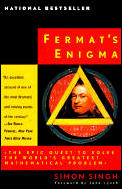
| Publisher: | Anchor |
| Copyright: | 1997 |
| Printing: | October 1998 |
| ISBN: | 0-385-49362-2 |
| Format: | Mass market |
| Pages: | 305 |
Fermat's Last Theorem is the infamous proposal that:
xn + yn = zn
has no solutions for integer x, y, z, n and n > 2. It's infamous for being very simple to state and understand, a variation on the equation produced by the Pythagorean Theorem, but incredibly difficult to prove. It's also infamous for Pierre de Fermat's maddening marginal note: "I have discovered a truly marvelous demonstration of this proposition which this margin is too narrow to contain." 350 years after Fermat wrote this, the theorem was still unproven in the general case, although the theorem for many specific values of n had since been proven.
Fermat's Enigma is a popular history of Fermat's Last Theorem and the attempts to prove it, the partial successes and famous failures. It's also the story of Andrew Wiles, a Princeton mathematics professor who finally proved the theorem in a complex, brilliant proof that builds on much of the power of modern mathematics and almost certainly did not follow the same path that Fermat himself did. If, in fact, Fermat had truly proven the theorem at all, something that we will probably never know.
Singh comes to this subject with a serious structural problem: he's trying to write a popular account that's accessible even to people who are hazy on algebra and unfamiliar with basic proof technique, but he's trying to tell the story of one of the most complex proofs in modern mathematics. He tries to avoid the problem by talking about personalities instead of mathematical details, mostly successfully. It helps that Fermat's Last Theorem has been tackled by a collection of colorful geniuses, and even the soft-spoken Wiles has a subtle dramatic charm. Still, he has to cover enough of the mathematics for the reader to follow, and I found those sections tedious and a little overdramatized. For example, I can see using a domino analogy once to explain inductive proof, but Singh belabors the analogy until it's painful and talks about infinite chains of infinite dominos as if he doesn't understand that such setups are common in even simple inductive proofs.
An excess of drama, cliche, and reptition are the largest problems with this book. Explaining why Fermat's Last Theorem is so interesting requires diving into areas of math that many readers have never paid attention to, and I got the impression that Singh felt he had to create as much drama as possible to keep people reading. Occasionally this works. The circumstances around Wiles's proof are inherently dramatic, a great conclusion to the story. But at times it feels forced, such as when Singh goes on about the wonder of absolute mathematical proof and the supposedly unique way that mathematicians are more rigorous than any other profession. I enjoyed the bits of history and connection he uncovers and explains despite his tone, rather than because of it. The book is based on a TV documentary, and I started wondering if some of the dramatic tone of television carried over into the book where it's more obvious and less useful.
Another difficulty of aiming at such a broad audience is that Singh can't dig too deeply into the aspects of this proof that make it so important to modern mathematics. Too much background in very difficult math would be needed, so his choice makes sense, but I have some of that background and I was wanting more. Wiles proved Fermat's Last Theorem by proving the Taniyama-Shimura conjecture, a fifty-year-old conjecture about a connection between elliptic curves and modular forms that had previously been shown to be equivalent to Fermat's Last Theorem, but which is considerably more important to the structure of mathematics. The Taniyama-Shimura conjecture covers a portion of the Langlands program, a series of conjectures about a deep unity between very disparate sections of mathematics that, if proven, would permit techniques of one branch of mathematics to be used to attack problems in a very different branch. Singh does cover this, but not in as much detail as I would have liked (I would have loved a good description of modular forms, for instance), nor does he talk much about the other aspects of the Langlands program or about the usefulness of the other theorems Wiles proved in the course of proving Taniyama-Shimura and Fermat's Last Theorem.
More detail here is probably a difficult request. From a quick glance through Wikipedia, it's not clear whether Singh could adequately explain the impact of the math even to someone with my mathematical background, and that would be abandoning much of his audience. Still, Fermat's Enigma left me a bit unsatisfied.
Worth reading, though, particularly for the last portion of the book. The detailed story of Wiles's proof is engrossing, dramatic, and matters for more reasons than just solving a long-standing puzzle. I'm not a big fan of Singh's writing style, but he does make the story accessible and includes several interesting nuggets of mathematical history.
Reviewed: 2007-01-14